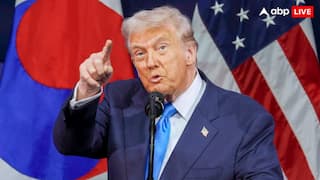Explorer
US Includes India In The 'Monitoring List' Of Currency Manipulators After Removal In 2019; Here's All About It
The Treasury found that 10 economies warrant placement on Treasury's 'Monitoring List' as close attention needs to be paid to their currency practices. These are China, Japan, Korea, Germany, Italy, Singapore, Malaysia, Taiwan, Thailand, and India.

Representational Image: Getty
Washington: The United States has included India along with Taiwan and Thailand in its 'monitoring list' of currency manipulating countries that includes trading giants like China and 6 others. ALSO READ | EPFO May Credit 8.5% Interest For 2019-20, Here's How To Check Balance Other countries on the monitoring list are Japan, South Korea, Germany, Italy, Singapore, and Malaysia. Besides them, Vietnam and Switzerland have also been labeled as currency manipulators. Meanwhile, Ireland was removed from the Watchlist as per the US Department of Treasury's report titled 'Macroeconomic and Foreign Exchange Policies of Major Trading Partners of the United States' submitted to the Congress on Wednesday. According to it, four major US trading partners that are Vietnam, Switzerland, India, and Singapore intervened in the foreign exchange market in a sustained, asymmetric manner over the four quarters through June 2020. The objective criteria established by Treasury to spot potentially unfair currency practices or excessive external imbalances are: - A bilateral trade surplus with the U.S. of more than $20 billion. - A current account surplus of at least 3% of GDP. - Net purchases of foreign currency of 2% of GDP over a 12-month period. Using these three benchmarks, it determines countries whose practices can impact US growth or harm American workers and firms. "The Treasury Department has taken a strong step today to safeguard economic growth and opportunity for American workers and businesses," said US Treasury Secretary Steven T Mnuchin. The Treasury found that 10 economies warrant placement on Treasury's 'Monitoring List' as close attention needs to be paid to their currency practices. These are China, Japan, Korea, Germany, Italy, Singapore, Malaysia, Taiwan, Thailand, and India. ALSO READ | Bitcoin Price: Cryptocurrency Surge Past $20,000, What The Rally Means For Investors?
India - US Trade
India is termed to have breached the first and the third benchmarks. On the second, the country’s current account surplus remained below the threshold level on a four-quarterly basis. For several years, India has maintained a significant bilateral goods trade surplus with the US reaching $22 billion in the four quarters through June 2020. Reserve Bank of India has regularly published intervention data which revealed that India's net purchases of foreign exchange accelerated notably in the second half of 2019, and during the onset of the Covid-19 pandemic, India sustained net purchases for much of the first half of 2020. The net purchases of foreign exchange reached $64 billion, or 2.4 percent of GDP, over the four quarters through June 2020. The Treasury shared that India's economy contracted sharply in the first half of the year 2020 because of the decline in domestic demand brought induced by the Coronavirus pandemic. This was met with a modest direct financial support of around two percent of GDP and some monetary easing. India's deep domestic demand contraction and slower recovery relative to its key trading partners contributed to the economy's first four-quarter current account surplus since 2004 (0.4 percent of GDP over the year to June 2020). The Treasury further went on to commend India as it said that "India has been exemplary in publishing its foreign exchange market intervention, publishing monthly spot purchases and sales and net forward activity with a two-month lag". Meanwhile, RBI stated that the value of the rupee is broadly determined by the market itself, intervention is used only to prevent undue volatility in the exchange rate. "Rupee volatility did not appear to have been particularly elevated in the four quarters through June 2020, however. These purchases have led to a rapid rise in total reserves that are now well in excess of standard reserve adequacy benchmarks. As of June 2020, foreign currency reserves stood at $466 billion, equal to 4.4 times gross short-term external debt. Reserves have continued to grow in recent months, reaching $502 billion in September 2020 as purchases accelerated further in July and August," it said. The Treasury had advised that Indian authorities allow exchange rates to move for reflecting economic fundamentals and limit its foreign exchange intervention to circumstances of disorderly market conditions. "By further opening the economy to foreign investors, India can also support economic recovery and bolster long-term growth," said the report. In its report, it went on to state how India can also leverage the recovery period to pursue structural reforms that can help open its market further to foreign investment and trade, including foreign portfolio investment in Indian sovereign and sub-sovereign bonds, thereby instilling stronger long-term growth. (With Agency Inputs) Follow Business News on ABP Live for more latest stories and trending topics. Watch breaking news and top headlines online on ABP News LIVE TV
Read more






































